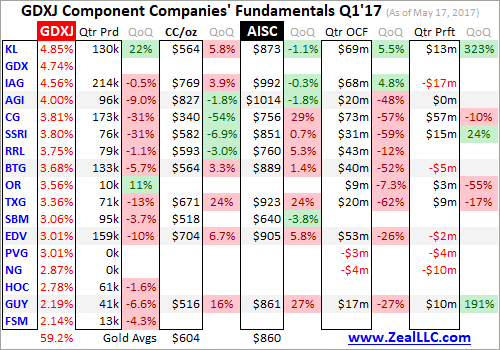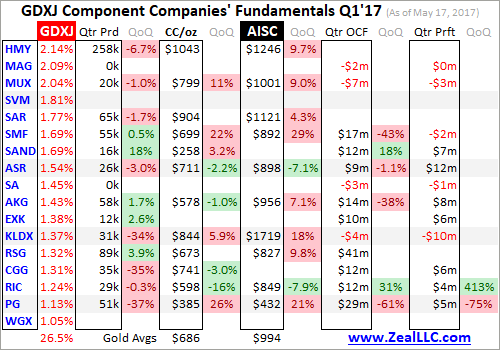Categories:
Base Metals
/
General Market Commentary
/
Precious Metals
Topics:
General Base Metals
/
General Market Commentary
/
General Precious Metals
Gold Juniors' Q1'17 Fundamentals
The junior gold miners' stocks suffered a serious thrashing between mid-April and early May. Relentless heavy selling blasted many back down near deep mid-December lows, leaving sentiment in tatters. But traders distracted by weak technicals need to keep their eyes on the fundamental ball. The gold juniors just finished their Q1 earnings season, which was solid. Their low stock prices are disconnected from reality.
Four times a year publicly-traded companies release treasure troves of valuable information in the form of quarterly reports. These are generally due by 45 days after quarter-ends in the US and Canada. They offer true and clear snapshots of what's really going on operationally, shattering the misconceptions bred by the ever-shifting winds of sentiment. There's no junior-gold-miner data that is more highly anticipated.
Until later last year, the definitive list of elite junior gold stocks to analyze came from the world's most-popular junior-gold-stock investment vehicle. The GDXJ VanEck Vectors Junior Gold Miners ETF was born in November 2009, and is the second-largest gold-stock ETF after its big brother GDX which tracks the larger major gold miners. Investors love junior gold miners' stellar potential, so GDXJ has been very popular.
Unfortunately this fame has recently created major problems severely hobbling the usefulness of GDXJ. This sector ETF has shifted from being beneficial for junior gold miners to outright harming them. GDXJ is literally advertised as a "Junior Gold Miners ETF". Investors only buy GDXJ shares because they think this ETF gives them direct exposure to junior gold miners' stocks. But that's increasingly becoming less true.
When capital flows into GDXJ as a proxy for owning junior gold miners, this ETF should be shunting that buying directly into junior gold miners' stocks. But GDXJ is no longer fully doing that. Instead some of these capital inflows are now stealthily diverted into larger gold miners' stocks, which is troubling. Investors who actually wanted to own majors would buy GDX rather than GDXJ. This junior ETF is failing its mission.
With capital explicitly intended by investors to buy juniors instead redirected into majors, the junior gold miners' stocks are being starved of capital inflows. Strong investment buying that should be propelling the juniors much higher isn't reaching them, which is quite frankly an outrage. That's not only hurting their present prices, but future potential too since buying begets buying. GDXJ is sabotaging the junior sector.
How did GDXJ go so wrong since the middle of last year? Ironically it's the victim of its own success. This leading junior-gold-miners ETF tracks an index called the MVIS Global Junior Gold Miners Index. MV Index Solutions is the indexing arm of VanEck, and its analysts have done a good job constructing their junior index for GDXJ to replicate. It contains most of the world's best junior gold miners and explorers.
The inclusion criteria are pretty simple. Companies need to have market caps over $150m, which is tiny. They must have average daily trading volume of $1m, also small. And they have to generate at least 50% of their revenues from gold or silver mining. As of this week, this index underlying GDXJ has 48 component companies. Many are great choices, though some are operating at mid-tier instead of junior scales.
Before mid-2016, GDXJ's composition was able to track this index as claimed. But in the first half of last year as gold surged 30% higher in its first new bull market in years, investors flooded into GDXJ to chase the soaring junior gold miners' stocks. This small ETF mirroring a small sector enjoyed massive capital inflows. GDXJ's net assets exploded from $1b to over $5b in that span, exceedingly large relative to its sector!
GDXJ attempted to shunt that capital into its underlying junior gold stocks as normal, which is the way ETFs are supposed to work. That's why ETF-share buying directly bids up underlying stocks. But GDXJ ran into multiple problems. This ETF's footprint in some component junior gold miners was so large that its ownership stakes approached 20%, a threshold that must not be crossed under Canadian securities law.
GDXJ is dominated by Canadian companies because that's where the great majority of the world's junior gold miners list and trade. This week Canadian companies accounted for nearly 2/3rds of GDXJ's net assets. In Canada once any investor including an ETF goes over 20% ownership, it is deemed to be a takeover offer which must then be automatically extended to all remaining shareholders on the same terms!
As a passive investor on behalf of its shareholders, GDXJ can't be acquiring and running gold miners. So this leading junior-gold-miners ETF had to simply stop investing in Canadian juniors nearing that 20% threshold! Instead GDXJ's managers started diverting the torrents of capital inflows into investments in larger gold miners that weren't a part of its mission or underlying index. That even included adding GDX.
Every quarter I analyze the latest results from major gold miners, junior gold miners, and silver miners using their respective leading ETFs' component lists. Sometime between Q2'16 and Q3'16, GDXJ's managers started buying GDX shares. GDX showed up as the third-largest component of GDXJ in both Q3'16and Q4'16, so I railed about it in both analyses. It was false advertising, GDXJ investors wanted juniors.
GDXJ's managers diverted capital intended for junior miners into other much-larger gold miners. Just this week for example, after GDX at GDXJ's second-biggest weighting the third- and fourth-largest are bigger mid-tier gold miners not even included in GDXJ's underlying index. So even right now with juniors not popular at all, at least 1/8th of the capital flowing into GDXJ for junior exposure isn't going to juniors!
That was much worse later last year, and GDXJ has other problems too. It has struggled periodically to comply with IRS diversification regulations in order to keep preferential tax treatment as a regulated investment company. GDXJ's underlying index is also what JNUG uses, that 3x leveraged ETF on junior gold miners. So vast quantities of GDXJ shares are often tied up as hedges underlying the crazy-volatile JNUG.
So GDXJ is really a mess, and is no longer the "Junior Gold Miners ETF" investors think they are buying. GDXJ's solution is troubling too, although it may be the only option. It will soon change the composition of its underlying index to include much-larger gold miners, well into the mid-tier realm. I generally define juniors as less than 300k ounces of annual gold production, mid-tiers from 300k to 1m, and majors over 1m.
So in terms of weightings, going forward GDXJ is going to be dominated by mid-tier gold minersinstead of juniors! Thus investors who really want exposure to junior gold miners are going to have to go back to directly buying shares in these individual companies. That's ultimately better, as junior gold miners with superior fundamentals will see stock-price upside dwarfing that of the ETFs overdiversified with laggards.
Sadly GDXJ is increasingly no longer what it advertises itself as and what investors think it is. GDXJ will continue to contain the world's best juniors, but their collective weightings will be smaller which means this ETF won't track their prices well. GDXJ will be more of a mid-tier gold miners ETF, with performance closer to the major-dominated GDX. Investors looking for junior exposure need to understand what's happening.
I'll absolutely continue my quarterly studies of gold miners' operating fundamentals, as this knowledge is essential to fuel our own trades outlined in our newsletters. But in future quarters I might have to lump all the GDX and GDXJ gold miners together, and then manually divide them out into major, mid-tier, and junior categories based on quarterlygold production of 250k+ ounces, 75k to 250k, and less than 75k.
But for the just-reported Q1'17, I'm sticking with my usual approach of looking at the top 34 "juniors" that are included in GDXJ. That number is arbitrary, it simply fits neatly into the tables below. Out of GDXJ's 56 component companies this week, 8 more than its underlying index, the top 34 command a dominant 85.6% of its total weighting. That GDX filler is ignored, but I wrote an essay on its miners' Q1 results last week.
Every quarter I wade through a ton of data from these elite gold juniors' quarterly reports, and dump it into a big spreadsheet for analysis. Some made it into these tables. If a field is blank, it usually means a company didn't report that data for Q1'17 as of this Wednesday. Some percentage changes are also left blank if that data went from positive to negative or vice versa. That actually happened quite a bit in Q1.
In these tables the first couple columns show each GDXJ component's symbol and weighting within this ETF as of this week. Only half these stocks are normally listed to trade in the US. So if you can't find a symbol, it's a listing from a company's primary foreign stock exchange usually in Canada or Australia. That's followed by each GDXJ component's Q1'17 gold production in ounces, mostly in pure-gold terms.
Most gold miners also produce byproduct metals like silver and copper. These are valuable, as they are sold to offset some of the considerable costs of gold mining. Some companies report their quarterly gold production including silver, a construct called gold-equivalent ounces. I only included GEOs if no pure-gold numbers were available. Financial and operational reporting varies greatly from company to company.
That's followed by the quarter-on-quarterchange, the absolute percentage difference between Q4'16 and Q1'17. This offers a more-granular read on gold miners' ongoing performance trends than year-over-year comparisons. QoQ changes are also listed for the rest of this data, which includes cash costs per ounce of gold mined, all-in sustaining costs per ounce, operating cash flows generated, and GAAP accounting profits.
After spending lots of time digesting these elite gold juniors' latest quarterly results, it's fully apparent their stocks' recent sharp selloff wasn't fundamentally-righteous at all! Gold-stock traders got scared because gold was sliding after gold-futures shorting attacks. That excessive herd fear pummeled this sector back down to fundamentally-absurd levels relative to prevailing gold prices, spawning incredible bargains.


Let's start with the top 34 GDXJ component miners' gold production in Q1'17, since everything else from profits to stock prices ultimately depend on it. These elite juniors collectively mined 2.1m ounces of gold in the first quarter. Interestingly GDXJ's 4 largest component miners not including GDX are also top-34 components of the latter major-gold-miners ETF. This brings up another longstanding frustration with GDXJ.
VanEck owns and manages GDX, GDXJ, and that MVIS indexing company that decides exactly which gold stocks are included in each. With one company in total control, GDX and GDXJ should have zero overlap in underlying companies! GDX or GDXJ inclusion should be mutually-exclusive based on the size of individual miners. That would make both GDX and GDXJ much more targeted and useful for investors.
The top 34 GDXJ gold miners' Q1 production actually fell a sharp 6.4% QoQ from Q4, which seems like an ominous omen. If the leading junior gold miners can't grow their production, that is bearish for their collective fundamentals. But interestingly, the world's gold miners have long seen sharp drops in gold production from Q4s to Q1s. I explained the reasons why in last week's analysis of GDX miners' Q1'17 results.
To continue reading please click link http://www.321gold.com/editorials/hamilton/hamilton051917.html